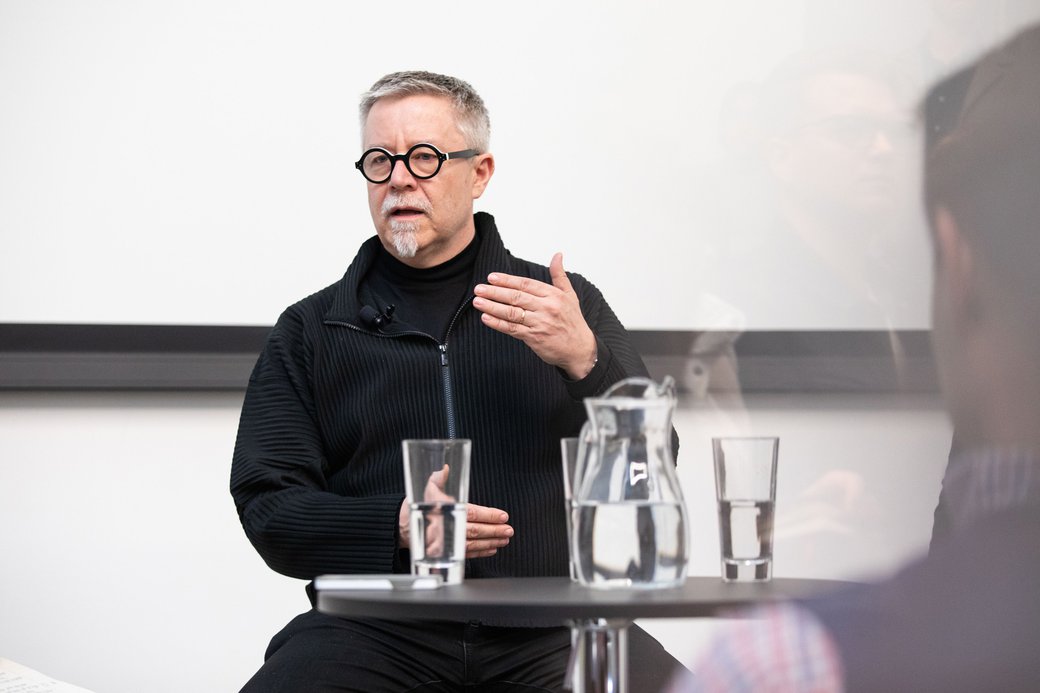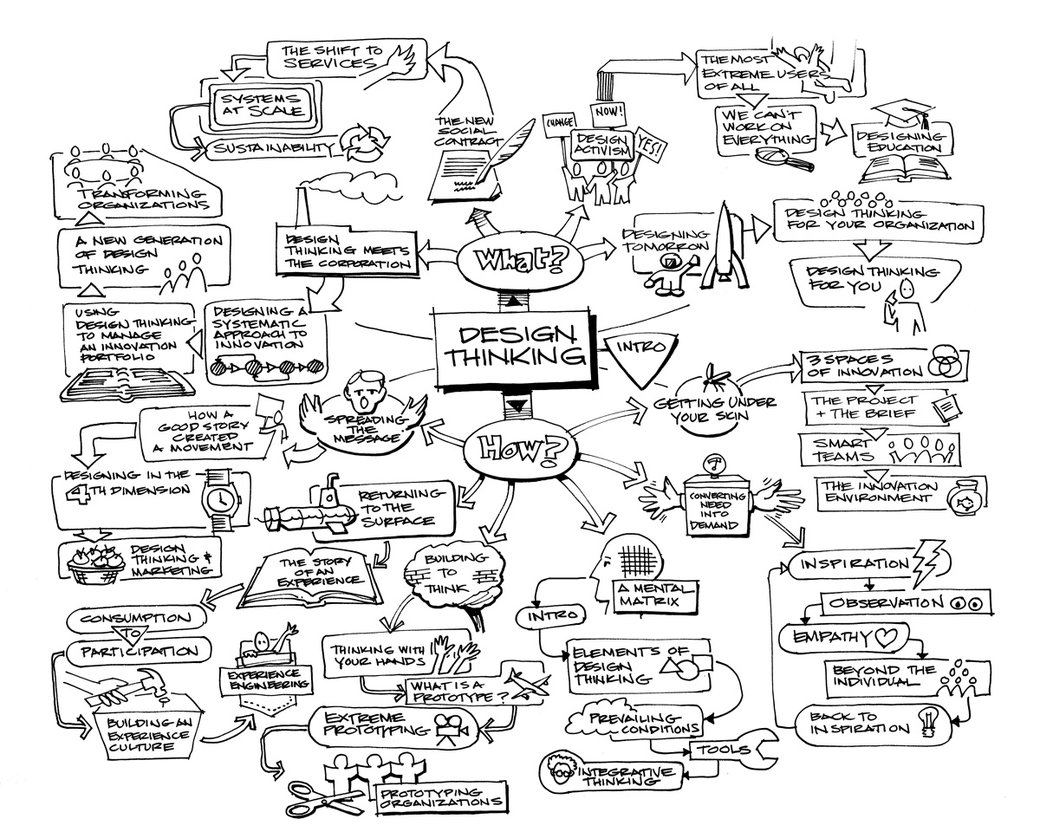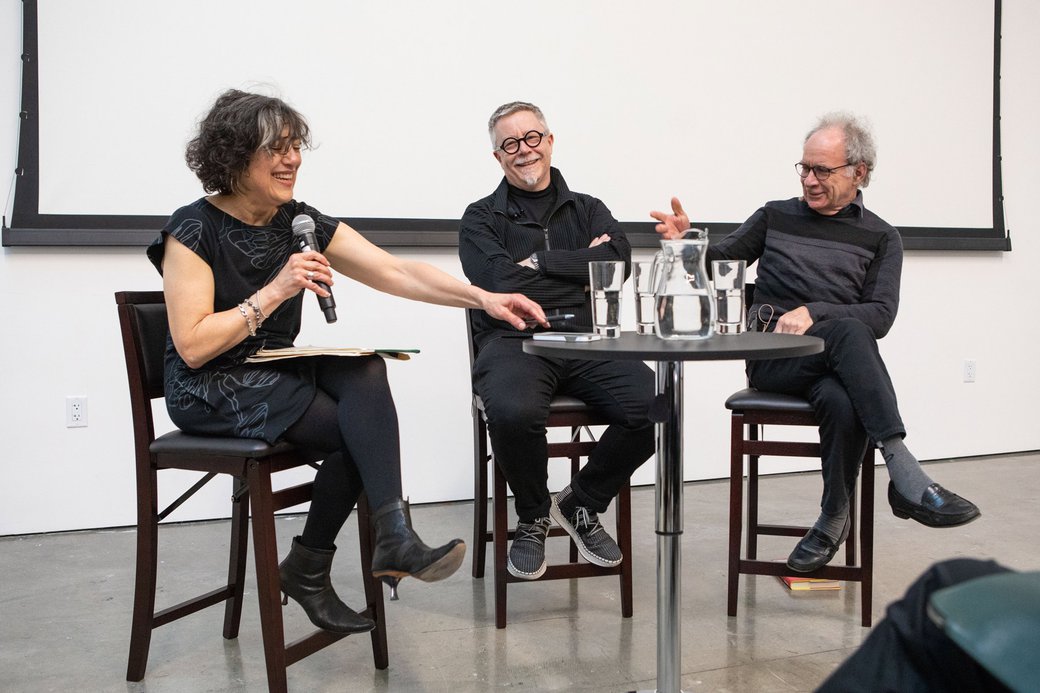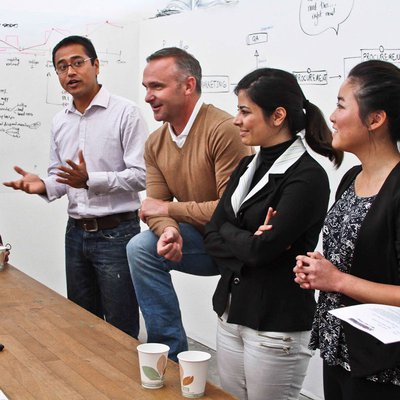
A conversation with IDEO’s Tim Brown + Barry Katz
IDEO CEO and CCA Trustee Tim Brown and CCA professor Barry Katz, who stunned the world with the argument that design methods could innovate almost everything, discuss design’s critical role in an era of unprecedented change.
A decade of design thinking

IDEO CEO and CCA Trustee Tim Brown
Leaders as designers, designers as leaders
Ten years ago, Tim Brown of IDEO—with the support of CCA professor of design and IDEO fellow Barry Katz—wrote Change By Design. This radical book revealed the approach to problem-solving we take as designers and laid it out as a way of thinking that could be practiced beyond the parameters of the field—indeed, under almost any circumstance where change is desired.
A 10th anniversary edition of Change By Design was released in March. As part of the Design Division Lecture Series, CCA hosted a conversation between Katz and Brown, moderated by associate chair of CCA’s MBA in Design Strategy (DMBA) Susan Worthman, for a packed audience. Before the event, I had the opportunity to meet with Katz to discuss the book, the evolving role of design and designers, and CCA’s longstanding relationship with IDEO.
“The context of design is constantly changing. … Mastery does matter. Design thinking is not a concept, like wallpaper, to be applied.”
IDEO CEO and CCA Trustee

Mindmap table of contents by Tim Brown, courtesy Barry Katz
Why has Change By Design had so much impact
The book Change By Design: How Design Thinking Transforms Organizations and Inspires Innovation shares the human-centered, user-research heavy, explorative, iteration-loving, inspiration-ideation-implementation cycle that we have come to know as “design thinking.”
Although it’s been popularized as a fixed, step-by-step methodology, design thinking actually proposes that the range of challenges appropriate for a designer to tackle is much greater than once conceived. It’s also a process of problem-solving that anyone can work with. Change By Design encourages us to see systems such as health, economics, data banks, and education as areas of action and discourse within a designer’s purview.
The first premise is important to the design community because it changes the kind of work we might consider doing, as well as broadens the concept of design for people who hire us. The second doesn’t mean that an untrained individual can simply read about and deploy the skills we’ve honed over years of education and practice, but it does suggest that the problem-solving techniques common to design professionals can be applied more broadly. Although Change By Design was written for an outside audience, for business and leadership, it’s been widely discussed within the design community itself.
Setting the record straight
“Design thinking” as a term is both deified and divisive. It’s been heralded as the future of education and a secret weapon for doing good, but also accused of homogenizing the way that design processes are conceived. The book itself has two main misconceptions that Katz wished to clarify when we spoke.
Design thinking is not a methodology
“The most flagrant misuse of this concept is in turning it into a methodology: Feed a problem into the front end of the ‘Design Thinking’ machine, turn the crank five times (brainstorm, prototype, user test…), and out spills an iPhone at the end of it!” he said. “No one who has ever worked in the design field has ever seen a project unfold like that. And it is a bill of goods to sell it as a methodology that non-designers can apply, and then make breakthroughs in the insurance industry, or the pharmaceutical industry, or anything else.”
It’s not, he adds, a “methodology that produces results that can be quantified. I would rather think of it as a philosophy.” It does describe and demystify some of what Katz calls designers’ “tricks”—the use of brainstorming, prototyping, user research, and the like. These tricks, Katz argues, “can be used to help people who are not designers think differently about what they already do.” But, as Brown described at the lecture event, “mastery does matter.” Design thinking, as Brown says, is “not a concept, like wallpaper, to be applied.”
IDEO didn’t invent design thinking
I asked Katz if he saw Brown and IDEO as having pioneered the process or if it was bubbling up around them, if they were more refiners and consolidators of the steps. He was clear that design thinking was not invented at IDEO and that its roots go back at least to the 1960s.
Nevertheless, their work led to a process that’s been cultivated and practiced at IDEO. The introduction to the new edition of Change By Design starts with a scene from the Charlie Chaplin film Modern Times. In the scene, Chaplin’s character has fallen from the back of a truck. He’s waving a red flag to alert the driver, just as a revolutionary mob comes around a corner behind him. As he begins to run, he inadvertently becomes the leader of the revolution. Brown and Katz jokingly allude to looking up and realizing that a revolution of design thinking was on their trail. It clearly wasn’t an accident, but as Katz describes, “We floated a concept and it took root. It happened at the right time.”
Why re-release the book?
At the talk in CCA’s Nave, Brown shed light on why they wanted to re-release the book, citing that “the context of design is constantly changing.” In our conversation, Katz told me that he and Brown had sat down to discuss whether anything significant had happened in the 10 years since the book was first published.
Their conclusion? “Oh, not much,” Katz joked. “Just the smartphone, autonomous vehicles, CRISPR gene editing, cloud computing, the maturing of artificial intelligence! You know, probably more fundamental transformative, disruptive technologies have appeared in the last 10 years than in any other decade in history.” The centrality of designers in the last decade’s developments reflects how much our work, and how the community at large imagines our work, has changed. The original book named this shift in what design thinking can do and was part of popularizing an understanding of it.
“The centrality of designers in the last decade’s developments reflects how much our work, and how the community at large imagines our work, has changed.”
CCA Critical Studies and MFA in Design faculty
In Worthman’s opening remarks at the CCA lecture, she looked back to 2009 and remembered it becoming clear that “design was the future of business, and that business was the future of design.” Our development at CCA reflects these shifts as well, with our MFA Design and DMBA programs having started in 2007 and our MDes in Interaction Design in 2015. These three distinct master’s degrees reflect the broad range of approaches we take to preparing students for the innovation, leadership, and change-making that designers can and do practice now.
Meet alumni from the MBA in Design Strategy program
IDEO and CCA’s deep connections
Brown served on the CCA Board of Trustees from 2004–2014, and more than 20 of our students have gone to work at IDEO and IDEO.org after graduation. Numerous current and former faculty have IDEO and IDEO.org affiliations, as well. Sometimes we see all three: A design student graduates from CCA, works at IDEO, and then comes back to CCA to teach. As Katz characterized, “We have a robust relationship that has been productive in both directions. Tim [Brown] is intimately connected to our institution.” Katz’s role as a fellow at IDEO has been “a transformative experience, spending two decades immersed in a world of practitioners,” one that he describes as having deeply enriched both his writing and teaching.
When I began teaching at CCA eight years ago, many of my students were dazzled by Pixar. Now I see that same dreaminess when I talk to them about IDEO. This is, of course, purely anecdotal and qualified by the random selection of whom I happen to have in my classroom, but I see them yearning to work in places that hire designers from multiple disciplines—places that value both their particular expertise with materials and tools, as well as their ability to see the potential for design to influence and remake large systems.
These students also perceive and admire that IDEO and other companies with similar approaches to practice—and there are many now—make large, public service, system-based projects as well as traditional commercial design projects. My graduate students recently had the privilege of visiting the San Francisco office of the global firm Daylight Design. We saw a prototype for a new baby stroller, then two CCA alumni team members shared a project they’re developing for the City of Santa Clara to support access to housing services through a multi-prong set of interventions and design-supported interactions. This is the kind of work we dream about now and the kind of work that design students at CCA think about and experiment with as we explore global interactions, international teams, and design challenges large and small.
What role does design play today?
Katz was in a meeting recently where someone asked, “What is the question to which design is the answer?” He has a few responses. One of his favorites: “Probing possible futures.” Another: “The humanization of new technologies,” in the way that we have done for steam, electricity, the computer, and beyond.
“We are faced with an avalanche of rather unprecedented new technologies, and the most immediate task in front of us is how to render them meaningful, accessible, how to humanize them,” Katz said. “We want to put those things on the agenda while it’s still possible for designers to be shaping them and not simply fixing them after the fact.”
“We are faced with an avalanche of rather unprecedented new technologies, and the most immediate task in front of us is how to render them meaningful, accessible, how to humanize them.”
CCA Professor and IDEO Fellow
In both my conversation with Katz and the lecture series event featuring him and Brown, we kept returning to the idea of data as a medium for design. A great example is the company OpenGov, a Bay Area company whose mission is “to empower a more effective and accountable government” by making complex data clear and functional for use within government agencies and for public access and understanding. The company is keenly aware that design is critical in organizing data into patterns and visualizations that are understandable and meaningful—and the role that plays in making meaningful impact and change.
The majority of OpenGov is made up of people from diverse backgrounds, including product designers, graphic designers, data visualization architects, product managers, product support team members, MBAs, accountants, budget and finance directors, and more. IDEO is thinking along these lines too; it recently acquired a firm in Chicago called Datascope, and its task is to figure out how to humanize big data and make it usable.
Pushing the boundaries forward
From policy to behavior to data and its acquisition, transmission, and use, all are shaping forces in contemporary life. Worthman described our time as dominated by algorithms that have the potential to narrow rather than broaden our choices. Brown noted that this is the nature of optimization—reducing the margin of error, getting more specific—and asked whether this is always what we want.
He affectionately described a library he used to visit where one could use a traditional system to look up specific books, but on the shelf, the desired book was surrounded by surprises. One might find “Neo Georgian Architecture next to a book on seashells,” he said. It was a system made “to create serendipity and chance.”
Optimization seeks the best fit, he explained, but design can also be used to expand choice, to connect to things we don’t expect to see. I’m thinking of how activist and author Jane Jacobs described the West Village: an urban system designed to offer efficient services entwined with chance encounters. Katz mused that there may be a difference between coding an algorithm and designing one. This reimagining of the optimal is certainly within the purview of a designer’s work.

Susan Worthman, Tim Brown, and Barry Katz at CCA’s Design Division Lecture Series
What’s next for design thinking?
Before closing the event, Worthman asked the panel, “What is it that’s needed next?” Brown said that we need to get design to the places that are less privileged, where we’ve had relatively little impact. Often when we try to do this, he said, “We are still outsiders coming in with our privileged perspectives. We need design that comes from the intuition of locals.” This perspective is as relevant to education as it is to professional practice and is a central focus at CCA. As Katz noted, we’re very much trying to make, and be, a global institution but “we are not there yet.”
In Katz’s view, it will come to fruition when talent flows in from around the globe; when we’re fostering cross-culture, cross-context exchange and working methods; and when we see that same talent start to flow back to its origins. This reimagining of our educational model as we enter a global, data-driven age, as we acknowledge the need for examining systems and outcomes even within the college as design opportunities, is certainly in the purview of our work. A willingness to question our own impact is one of the responsibilities of educators; it places us in a leadership position to guide and empower the next generation of designers to address the future of data, optimization, and design democratization.

Push boundaries and lead conversations that transform culture









